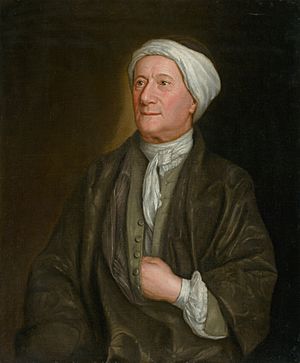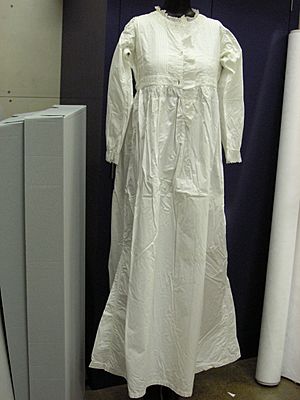Nightgown facts for kids
A nightgown or nightdress is a comfy dress you wear to sleep in. It's usually loose, so it's easy to move around in. Nightgowns come in many lengths. Some are short, like a "baby-doll" style that reaches your hips. Others are long, like a "négligée" that goes to the floor. You can also find them knee-length. Before the 1940s, men often wore nightgowns. Today, they are mostly worn by women.
Contents
History of Nightgowns
Early Sleepwear
The word "nightgown" was first used around 1530. But it's not clear if it meant sleepwear back then. There isn't much proof of special sleep clothes before the 1500s. Some historians think this is because sleepwear was a private thing. People didn't talk about it much.
Modern nightgowns came from "nightshirts" for men and "night-chemises" for women. These started in the 1500s. They were often just regular day shirts or underwear. They were long, shapeless, and reached the ankles. Nightshirts looked like tunics. Both men and women wore tunics for centuries in ancient Egypt and Rome. Early nightshirts were usually made of white linen. This made them easy to wash and good at soaking up sweat. Rich people, however, had embroidered nightshirts.
Sleepwear started to become its own type of clothing in Western Europe in the late 1600s. Wealthy women began wearing special chemise-like gowns only for bed. These were called nightshifts. In the early 1700s, the "négligée" was created in France. This made nightshifts more stylish. The negligée was often made from soft, see-through fabric. It was tighter around the waist but still loose for comfort. It also showed that someone was wealthy. The negligée is seen as the first popular women's nightwear. It was a step towards the modern nightgown.
Nightgowns as Dressing Gowns
Before the late 1800s, the word "nightgown" didn't mean sleepwear. Instead, it was a type of casual clothing. It was like a "modern dressing gown." People wore it around the house or for informal events. This garment was actually called a "Banyan." It was a T-shirt shaped robe that the British copied from India. But in the early 1700s, it became known as a "nightgown," "dressing gown," or "morning gown." This was because it was so casual.
Men mostly wore these dressing gowns. English versions of the nightgown were inspired by similar robes from India, Japan, and the Middle East. In the early 1700s, the "kimono" style became popular. It was loose and fit over men like a coat. These gowns were made from two pieces of fabric sewn together at the back. They fell over the shoulders to make the front. Extra fabric formed the sleeves.
Dressing gowns were often made from cotton or silk. Fancy silks like damask, brocade, velvet, taffeta, and satin were used. Wool was also used. Linings were often bright satin. The material changed based on the weather. In colder times, nightgowns had fur linings. Trade between Europe and Asia from the 1500s to 1700s brought these foreign fabrics and styles. The exotic look made these nightgowns very popular. Especially the kimono or banyan styles. Some historians think the way these gowns were cut came from Persian and Turkish robes called caftans.
Dressing gowns also became popular because they showed off a person's status. They appear in many paintings from the 1600s and 1700s. For example, King Henry VIII wore a robe that looked like an Islamic caftan in a painting. Other paintings show that these gowns were fine to wear for work or social events.
Nightgowns in the 1800s and 1900s
From 1840 to 1900, nightgowns changed their look. Necklines, collars, sleeves, and how they closed all became different. The traditional nightshirt was replaced by pajamas in the Western world. Pajamas came from India in 1870. They quickly became a must-have for men because they were comfy and had an exotic feel. Women's pajamas were introduced in 1886. They were a mix of a nightgown and pants. The top had a high collar and buttons. It also had frills at the wrists and knees. French designer Coco Chanel later made stylish women's pajamas. This helped them become very popular.
Even with pajamas, nightgowns became much more popular in the 1920s. From 1920 to 1940, nightgowns didn't hug the body. Instead, they hung straight down. This was largely thanks to French designer Madeleine Vionnet. She didn't like corsets. She became famous for cutting fabric "on the bias." This means cutting it diagonally. Her styles showed off curves while still being flowy and comfortable. During this time, nightgowns also moved from just being for home to becoming fashion statements. By the 1960s, nightgowns were very diverse. You could find them in many lengths, patterns, and fabrics.
Nightgowns Today
In the 21st century, nightgowns are mostly worn by women. Modern nightgowns are often made from cotton, satin, silk, or lace. They usually have pretty embroidery or lace details. They also often have thin shoulder straps. Nightgowns come in several styles. Longer cotton nightgowns are sometimes called "Victorian Nightgowns." They look like styles from the late 1800s. Shorter nightgowns are also known as "nighties." A common short style is the "babydoll" nightgown. It's usually lace and silk with a V-neckline. Other styles include the "shirt style" nightgown or the "slip dress" nightgown.
Nightgowns in Fashion
The many styles of nightgowns have also made their way into regular clothes. You can see nightgown influences in street style and high fashion. In the 1990s, designer Calvin Klein created a line of dresses that looked like nightgowns. They were simple silk gowns, either short or floor-length. More recently, in 2019, actor Gwyneth Paltrow wore a sheer yellow lace nightgown on the red carpet. It had a high neck and full collar, much like a 19th-century style. Some experts think that as everyday clothes have become more relaxed, nightgowns have been able to become part of different daily styles.
Images for kids









